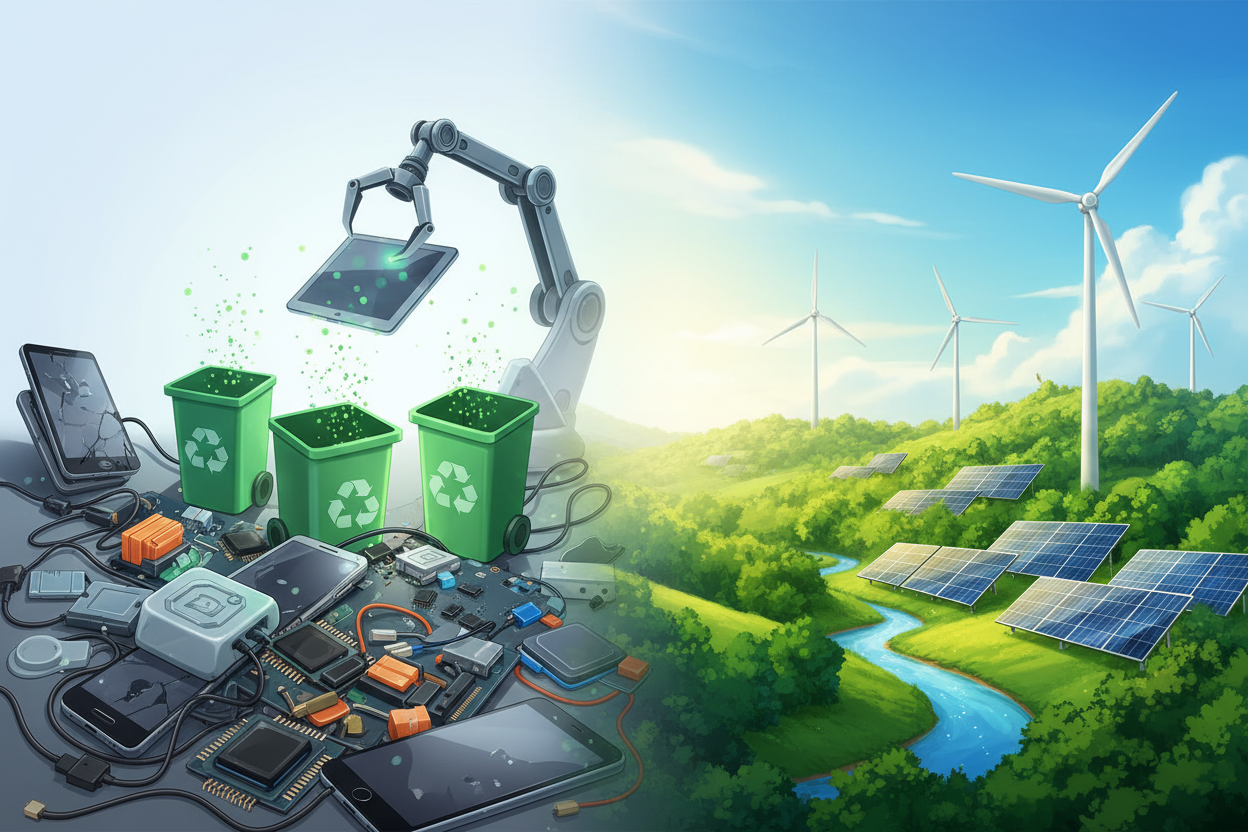E-Waste Recycling Leads to a Cleaner, Greener Tomorrow

Introduction: The Growing Need for Responsible E-waste Management
In today’s digital era, electronic devices have become essential to our daily lives — from smartphones and laptops to televisions and home appliances. However, the rapid replacement of gadgets has led to a serious issue: electronic waste (e-waste). Improper disposal of these items harms our environment and health. E-waste recycling has therefore emerged as a critical solution to minimize pollution and recover valuable resources. By promoting sustainable waste management, we can reduce e-waste and create a cleaner, greener tomorrow. This article explores how recycling electronics benefits both people and the planet — and how you can be part of the change.
Understanding E-waste: What It Really Means
E-waste refers to discarded electronic devices that are no longer functional or have become obsolete. This includes everything from old computers, smartphones, and televisions to printers, washing machines, and other appliances. The rapid pace of technological innovation and frequent upgrades have accelerated the accumulation of e-waste worldwide. According to the Global E-Waste Monitor, over 50 million metric tons of e-waste are generated annually, and this number continues to rise.
Improper disposal of e-waste poses serious environmental threats. Many electronics contain hazardous substances like mercury, lead, cadmium, and brominated flame retardants, which can contaminate soil and water when dumped in landfills. These toxic elements harm wildlife and pose health risks such as respiratory issues, organ damage, and neurological problems in humans. Moreover, the loss of valuable materials like gold, copper, and aluminum through improper disposal leads to unnecessary depletion of natural resources. E-waste recycling thus becomes essential—not just for waste management, but also for resource conservation and environmental protection.
-
E-waste refers to discarded electronic products — anything with a plug, battery, or circuit board.
-
Common examples include old computers, smartphones and chargers, printers.
-
With technology evolving rapidly, millions of devices become obsolete each year, contributing to rising e-waste globally.
-
According to recent environmental studies, over 50 million tons of e-waste are produced annually worldwide, with only about 20% recycled properly.
-
The remaining waste ends up in landfills, releasing toxic chemicals like mercury, lead, and cadmium into the soil and water.
-
Proper e-waste recycling is essential to prevent environmental damage and promote sustainable waste management.
Why E-waste Recycling is Crucial for the Environment
-
E-waste contains valuable materials such as gold, silver, copper, and palladium, which can be recovered through recycling.
-
Recycling prevents these materials from being wasted and reduces the need for mining, which often harms ecosystems.
-
Toxic components found in electronics, when dumped, can contaminate groundwater and air, leading to severe health issues.
-
Recycling helps in reducing greenhouse gas emissions, as the process of reusing materials consumes less energy than producing new ones.
-
It also supports the circular economy, where products are reused, repaired, and recycled instead of discarded.
-
Each recycled electronic item contributes to a cleaner environment, ensuring a greener tomorrow for future generations.
The Process of E-waste Recycling: Step by Step
-
Collection and Transportation:
-
E-waste is collected from homes, offices, and collection centers.
-
Specialized recycling companies or municipalities handle its transportation to recycling facilities.
-
-
Sorting and Dismantling:
-
Devices are manually dismantled into parts — screens, batteries, circuit boards, plastics, and metals.
-
Hazardous components are carefully separated to avoid contamination.
-
-
Shredding and Material Recovery:
-
The parts are shredded into small pieces for easier sorting.
-
Advanced technologies like magnetic separation and eddy current systems separate metals and plastics.
-
-
Extraction of Valuable Materials:
-
Gold, copper, aluminum, and other materials are recovered for reuse in new products.
-
These recovered elements are refined for manufacturing purposes, reducing dependence on raw materials.
-
-
Safe Disposal of Non-recyclable Materials:
-
Non-reusable components are treated or disposed of in environmentally safe ways.
-
-
This e-waste recycling process ensures valuable resources are conserved, pollution is minimized, and a sustainable waste management system is maintained.
Health and Social Impacts of Improper E-waste Disposal
-
Exposure to toxic chemicals from dumped electronics can cause serious health problems, including respiratory and neurological disorders.
-
Informal recycling or burning e-waste releases dangerous fumes, affecting workers and surrounding communities.
-
In many developing regions, unsafe handling of e-waste endangers children and workers who are unaware of the risks.
-
Proper e-waste recycling protects not only the environment but also the health and safety of those involved in waste management.
-
Promoting formal recycling systems ensures social responsibility, providing jobs in safe, regulated environments.
Economic Benefits of E-waste Recycling
-
E-waste recycling creates a valuable secondary resource market by recovering metals and plastics.
-
It reduces the cost of manufacturing by reusing materials instead of extracting new ones.
-
Governments and businesses can save billions annually through proper sustainable waste programs.
-
The recycling industry also generates green jobs, boosting local economies and supporting technological innovation.
-
As demand for electronics continues to grow, e-waste recycling will play a vital role in meeting material needs sustainably.
Role of Individuals in Promoting E-waste Recycling
-
Each individual can contribute to a cleaner environment by responsibly managing their old electronics.
-
Avoid dumping or burning e-waste — instead, donate, reuse, or recycle through authorized collection centers.
-
Support brands that follow eco-friendly production and take-back programs.
-
Educate others about sustainable waste practices and encourage participation in community recycling drives.
-
By adopting small changes, such as repairing gadgets or extending their lifespan, everyone can help minimize e-waste generation.
How E-waste Recycling Works
The e-waste recycling process involves several crucial stages, each designed to recover valuable materials and safely handle hazardous components.
-
Collection and Transportation:
The process begins with the collection of e-waste from households, offices, and recycling centers. The collected items are then transported to authorized recycling facilities. -
Sorting and Dismantling:
Once at the facility, e-waste is sorted based on type and composition. Skilled workers dismantle devices manually or mechanically to separate components such as circuit boards, plastics, metals, and glass. -
Data Destruction:
Before recycling begins, all personal and confidential data from electronic devices is permanently erased to ensure privacy and security. -
Shredding and Material Separation:
The dismantled parts are shredded into small pieces. Advanced separation techniques like magnetic, eddy current, and water separation are used to segregate metals, plastics, and other materials. -
Recovery and Refining:
Valuable materials such as gold, silver, copper, and aluminum are recovered through chemical or electrochemical processes. These refined materials are then reused to manufacture new electronic components. -
Safe Disposal of Residuals:
Any non-recyclable or hazardous residues are safely treated and disposed of in compliance with environmental standards.
Technological Innovations in E-waste Recycling (2025)
-
New technologies are revolutionizing e-waste recycling by improving efficiency and recovery rates.
-
AI-powered sorting machines can identify materials faster and more accurately.
-
Robotic dismantlers are used to safely separate components without human exposure to toxins.
-
Hydrometallurgical and biotechnological methods help extract metals with minimal environmental damage.
-
Blockchain tracking systems ensure transparency in recycling processes, verifying where and how waste is handled.
-
These innovations are shaping the future of sustainable waste management, making the dream of a cleaner, greener tomorrow a reality.
Global Perspective: E-waste Recycling Around the World
-
Countries have established efficient e-waste collection and recycling programs.
-
These nations emphasize public participation, extended producer responsibility, and strict regulations.
-
Developing countries, however, still struggle with informal e-waste recycling, leading to pollution and health risks.
-
International cooperation is needed to create uniform sustainable waste policies and share technology.
-
As more nations invest in recycling infrastructure, the global community moves closer to achieving environmental balance.
Future of E-waste Recycling — Building a Circular Economy
-
The future lies in building a circular economy, where products are reused, repaired, and recycled.
-
Manufacturers will need to design gadgets with modular components that are easier to upgrade instead of replace.
-
Consumers will play a central role by adopting eco-conscious habits and supporting sustainable brands.
-
Together, these efforts will significantly reduce landfill waste, lower emissions, and ensure long-term environmental protection.
-
A cleaner, greener tomorrow depends on our collective commitment to smarter, sustainable waste practices.
Simple Steps You Can Take to Recycle E-waste
- Find Authorized Centers: Locate certified e-waste recycling centers or drop-off points near your area.
- Delete Data: Before recycling, wipe personal data from devices for privacy protection.
- Avoid Throwing in Trash: Never dispose of electronics in regular garbage bins.
- Join Recycling Drives: Participate in community initiatives promoting sustainable waste management.
- Support Green Brands: Choose manufacturers that offer recycling programs and eco-friendly packaging.
By following these simple actions, you directly contribute to reducing environmental pollution and creating a greener tomorrow.
Conclusion: Towards a Cleaner, Greener Future
The journey toward a cleaner, greener tomorrow begins with every individual’s decision to recycle and manage e-waste responsibly. Each electronic device we recycle saves energy, reduces pollution, and recovers precious materials for future use. By embracing sustainable waste management, we not only protect the planet but also build a healthier environment for generations to come. Governments, businesses, and individuals in every country must join forces to make e-waste recycling a universal habit. Together, our collective action can turn discarded electronics into valuable resources — paving the way for a more sustainable and eco-friendly future.
FAQs about E-waste Recycling
Q.1. What is e-waste recycling?
E-waste recycling is the process of safely recovering and reusing materials from discarded electronic devices to reduce pollution and resource waste.
Q.2. Why is e-waste recycling important?
It prevents toxic chemicals from harming the environment, conserves resources, and supports a sustainable, circular economy.
Q.3. How can individuals contribute to e-waste recycling?
By donating, repairing, or dropping off old electronics at authorized recycling centers instead of throwing them away.
Q.4. What happens to recycled electronics?
They are dismantled, and valuable materials like gold, copper, and plastics are recovered for reuse in new products.
Q.5. What are the benefits of e-waste recycling?
It reduces environmental pollution, saves energy, creates jobs, and helps build a cleaner, greener tomorrow.





